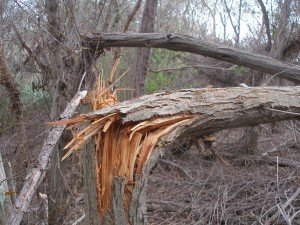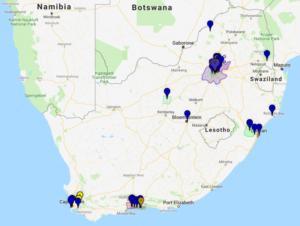willow tree killed by Kuroshio shot hole borer in Tijuana River estuary (John Boland photo)
I have blogged several times about damage caused to riparian trees in southern California by polyphagous (PSHB) and Kuroshio Shot Hole Borers (KSHB) (collectively known as invasive shot hole borers, or ISHB). The most recent blog – in July – reported the rising intensity of ISHB infestation in Orange County parks. The polyphagous shot hole borer and its associated Fusarium fungus have been found throughout Los Angeles, Orange, Riverside, San Bernardino, and Ventura Counties. The genetically distinct but morphologically indistinguishable Kuroshio shot hole borer occurs in San Diego, Orange, Santa Barbara, and San Luis Obispo Counties. New outbreaks continue to be detected – for example, one near San Juan de Capistrano.
The threat to wildland, rural, and urban hardwood forests in southern California is obvious (see the write-up here, but this is not the full extent of the peril. Preliminary research indicates that the ISHB can survive as far north as Tehama County (at the northern end of the Central Valley, south of Redding), and possibly in other parts of the country (see Greer et al., referenced below). The two beetles reproduce in more than five dozen tree and shrub species – both native and ornamental trees – that grow not just in California but across the country.
It is agreed that the ISHB do best in well-watered trees – e.g., trees in parks or other urban areas, and in riparian zones. Some fear that when the southern California drought ends, large areas of hardwood forests will become newly vulnerable. The role of water also raises the potential threat to the many species of reproductive host trees growing in the Gulf Coast and other warm and humid regions of the country.
What can people and agencies do now to counter these damaging pests? Several experts who have been working with ISHB in southern California have developed a management strategy for guiding and prioritizing actions and implementing control mechanisms targetting the beetles and their fungal symbionts that together cause the plant disease Fusarium dieback (FD). See Greer et al. Southern Calif Shot Hole Borers/Fusarium Dieback Management Strategy – full reference and link provided at the end of the blog.
This strategy attempted to advise managers on addressing outbreaks in both natural and urban landscapes at a period of rapid spread of the pests. It includes sections on establishing a leadership and coordination entity, inventory and monitoring, short-term management options, public outreach, and research to identify long-term management strategies. I don’t believe the plan’s proponents have secured funding to implement it.
Meanwhile, the California Department of Food and Agriculture and other state agencies have been officially charged by the state legislature with developing a management strategy and coordinating efforts (see another of my blogs from July). I have been told that the state agencies are working with the southern California experts in developing the state’s strategy.
The USDA Animal and Plant Health Inspection Service (APHIS) has been instructed by the Congress (in the report accompanying appropriation of funds for the Department of Agriculture) to enhance its engagement with ISHB – beyond funding provided in the past under Section 10007 of the Farm Bill. APHIS has created a Federal Task Force which is focused on three shot hole borers – in addition to the Kuroshio and polyphagous shot hole borers, also the tea shot hole borer. Several USDA agencies in addition to APHIS — Forest Service, Agriculture Research Service – as well as the U.S. Fish and Wildlife Service are developing an outline of federal agencies’ roles and responsibilities in light of state actions. The work is at an early stage.
I look forward to learning more about how each of these players plans to proceed.
Certainly, managing ISHB infestation and spread is extremely difficult. Current options in production agriculture (avocados are damaged by the pest/disease complex) and urban forests focus on the use of pesticides and removal of infested material. Then the wood and bark must be safeguarded against insects’ escape until the wood can be chipped and the insect larvae killed, for example, by using heat from solar radiation (solarization). Management options in the natural setting are limited to removal, chipping, and solarization of infested material. In any habitat, there are many logistical challenges when managing large amounts of wood.
The pest-derived difficulties have been magnified by the absence until recently of the official agencies with responsibility for managing “plant pests” (as I have complained in many blogs over the years). I hope the state and federal agencies now becoming involved will coordinate their efforts – among themselves and with the many academics, locally based agency staffs, and volunteers who have been working so hard over the past several years to counter these invaders. [To learn about these efforts, visit here.]
You have an opportunity to learn more about the shot hole borers by participating in the upcoming annual meeting of the Continental Dialogue on Non-Native Forest Insects and Diseases in November. Our meeting this year is in Irvine, California – in the infestation zone. The meeting will follow the general schedule below:
- Nov 5th: Travel day with informal evening social for those arriving early
- Nov 6th: Dialogue Meeting all day (8am – 5pm)
- Nov 7th: Joint CFD / Arbor Day Meeting and Field Trips (including one focused on ISHB) (8am- 5pm), Networking Reception (6-8pm).
Here are the quick links of interest:
- General meeting information: https://continentalforestdialogue.org/continental-dialogue-meeting-november-2018/
- Dialogue-specific page on Arbor Day site:https://www.arborday.org/programs/pcf/partnering-event-continental-dialogue.cfm
- Hotel information: https://www.arborday.org/programs/pcf/hotel.cfm
Some of you might also participate in the periodic workshops about the several tree-killing pests invading southern California. UC Cooperative Extension San Diego will host an Invasive Tree Pests Workshop on Friday, October 19, 2018 in Mission Beach San Diego from 9:00am-2:45pm. This workshop will focus on Goldspotted Oak Borer, Invasive Shot Hole Borers, South American Palm Weevil, and pesticide law & regulation. CEU’s have been requested from the California Department of Pesticide Regulation and Western Chapter International Society of Arboriculture. Registration is $30/person and lunch will be provided. Go to GSOB.org.
Reference
Greer, K., K. Rice, S.C. Lynch. Southern Calif Shot Hole Borers/Fusarium Dieback Management Strategy for Natural and Urban Landscapes. July 2018
P.S. The polyphagous shot hole borer has been detected at numerous sites in South Africa. One of several web-based sources of information is here
Posted by Faith Campbell
We welcome comments that supplement or correct factual information, suggest new approaches, or promote thoughtful consideration. We post comments that disagree with us — but not those we judge to be not civil or inflammatory.

